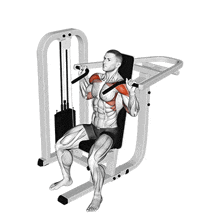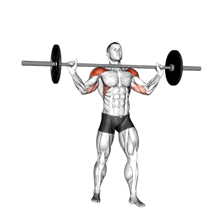Shoulder Press vs Overhead Press — sounds similar, right? But don’t let the names fool you.
A lot of people get these two mixed up. Honestly, it’s easy to do. They both work your shoulders. They both involve pushing something above your head. But they’re not the same.
One’s usually done sitting down. The other? You’re standing and using your whole body. One’s great for building size. The other’s better for total-body strength.
Not sure which one you should be doing? Or what the difference really is? No worries.
This guide breaks it all down — simple, quick, and real talk.
Shoulder Press vs Overhead Press: What Are They Exactly
Both the Shoulder Press and Overhead Press are upper-body exercises where you press weight above your head. Sounds similar, right?
But here’s the key difference: Shoulder Press is usually done sitting down, using dumbbells or machines. Overhead Press is done standing, often with a barbell, and your whole body gets involved.
Let’s break them down.
Shoulder Press
The Shoulder Press is a seated movement where you push dumbbells—or use a machine—up over your head. Since you’re sitting, your lower body stays out of it. The backrest supports you, making it more stable and easier to control.

🎯 Target Muscles
Mainly the front and side delts (shoulders). Minimal help from your core or legs.
✅ Benefits
- Great for isolating shoulder muscles
- Easier for beginners to learn
- Less risk of losing balance
- Good for building size in your delts
👌 Best For
- Beginners
- Anyone with lower back issues
- People focusing on shoulder hypertrophy
Overhead Press
The Overhead Press is a standing movement, usually done with a barbell. You press the weight from shoulder height to overhead—while keeping your whole body tight and balanced. It’s not just about the shoulders anymore.

🎯 Target Muscles
Still hits your delts, but also works your core, upper chest, traps, and glutes for balance.
✅ Benefits
- Builds full-body strength
- Improves posture and stability
- Great for functional, athletic power
👌 Best For
- Intermediate or advanced lifters
- People training for strength or performance
- Anyone who wants more than just big shoulders
Shoulder Press vs Overhead Press: What’s the Difference
So now that you know what each one is… how are they actually different?
Here’s a simple side-by-side look that makes it super easy to compare:
| Feature / Focus | Shoulder Press | Overhead Press |
|---|---|---|
| Position | Sitting on a bench | Standing upright |
| Stability | More stable (you’re supported) | Less stable (you balance everything) |
| Core Activation | Low | High – abs, back, glutes all working |
| Muscle Focus | Shoulders (mainly front and side delts) | Shoulders + Core + Traps + Upper Chest |
| Equipment | Dumbbells or machine | Barbell or dumbbells |
| Difficulty Level | Easier to learn, easier to control | More technical, requires coordination |
| Best For | Beginners, isolation, shoulder hypertrophy | Full-body strength, athletic training |
You see the difference now?
Shoulder Press is all about control and targeting your delts. You stay stable, focus on the muscle, and that’s it.
Overhead Press, though? It’s a team effort. Shoulders lead the way, but your whole body joins in.
Neither one is “better.” It all comes down to your goal.
Which One Should You Do?
Not sure whether to go with the Shoulder Press or the Overhead Press?
Here’s how to choose—real quick and straight to the point👇
✅ Goal: Bigger Shoulders
Pick: Shoulder Press
- More stable = more focus on delts
- Great for muscle growth
✅ Goal: Full-Body Strength
Pick: Overhead Press
- Works shoulders + core + back
- Builds total pushing power
✅ You’re a Beginner
Pick: Shoulder Press
- Easier to learn
- Lower risk of injury
✅ You Have Back or Balance Issues
Pick: Shoulder Press
- Bench gives support
- Less stress on spine
✅ You Want More Athletic Training
Pick: Overhead Press
- Improves coordination
- Mimics real-life movements
✅ Want the Best of Both?
Train Both
- Do Shoulder Press for volume (higher reps)
- Do Overhead Press for strength (lower reps)
- Example:
- Monday – Overhead Press
- Thursday – Shoulder Press
- Monday – Overhead Press
How to Train Both Shoulder Press and Overhead Press
Can you train both?
Absolutely. And you should—if you want the best of both worlds.
Shoulder Press builds muscle. Overhead Press builds strength and coordination. Together, they hit your shoulders from all angles and boost results faster.
Here’s how to make it work without overtraining:
| Day | Exercise | Focus | How to Do It |
|---|---|---|---|
| Monday | Overhead Press | Strength | 4 sets of 5 reps (heavy weight) |
| Thursday | Shoulder Press | Muscle Growth | 3 sets of 10–12 reps (controlled form) |
💡 Why This Works
- Overhead Press is heavier and more demanding, so do it earlier in the week when you’re fresh
- Shoulder Press is more isolated—perfect for high-rep hypertrophy later in the week
- You get strength + size without burning out your shoulders
✅ Pro Tips
- Don’t do both on the same day
- Always warm up your shoulders before pressing
- If you feel fatigue or joint pain—dial back volume, not form
- Switch dumbbells/barbells now and then to mix it up
So—Shoulder Press vs Overhead Press. Not the same. Not interchangeable. But both super useful.
Wanna grow big, round shoulders? Go with the Shoulder Press.
Want full-body strength and real-world power? Add the Overhead Press.
Wanna be smart? Train both.
Just keep your form clean, don’t rush the weight, and stick to a plan that makes sense.
You don’t need to overthink it.
You just need to start.
Pick one. Load up. Press up. Repeat.
Your shoulders will thank you later.

Hi, I’m Alex Carter, part of the editorial team at Leadman Fitness. We specialize in crafting premium custom racks, cable machines, functional trainers, and strength accessories for home and commercial gyms. With a background in competitive powerlifting and gym design consulting, I’ve spent years testing gear under heavy loads and optimizing layouts for efficiency.
I focus on translating real-world user frustrations—like space limitations, budget constraints, or durability needs—into actionable solutions. By collaborating directly with our engineers and facility owners, I ensure our custom equipment evolves to solve the unspoken challenges lifters face daily. What I share isn’t textbook advice; it’s battle-tested insight from racks I’ve welded, cables I’ve replaced, and gym floors I’ve trained on.
